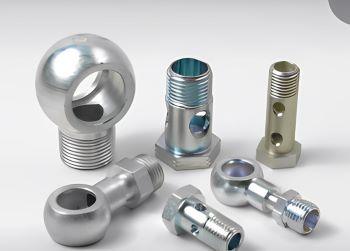Have you ever looked under the hood of your car or behind a washing machine and seen those oddly shaped fittings with a rounded body and a bolt coming out? Those are banjo fittings, and they’re little workhorses in the world of fluid systems.
But how exactly do these seemingly simple components create a secure connection? Let’s delve into the fascinating world of banjo fittings and explore their inner workings.
Inside the Banjo Fitting
A banjo fitting might look simple, but it’s made up of a few key parts that work together to create a leak-proof seal. Here’s a breakdown of the main players:
➡️ Body: The banjo’s body is the base, shaped like a half-moon with a threaded hole on one end. This hole allows the body to screw onto another component in the system.
➡️ Nipple: The nipple is a threaded insert that screws into the body’s threaded hole. It provides a secure connection point for the tubing or pipe.
➡️ Ferrule: The ferrule is a ring-shaped piece typically made of metal. It slides onto the tubing or pipe and gets compressed between the nipple and the body nut, creating the watertight seal.
➡️ Optional Crush Washer: In some banjo fittings, you might find a crush washer placed between the body and the ferrule. This washer provides an extra layer of sealing, especially useful for high-pressure applications.
How it Works: A Step-by-Step Guide
Assembling a banjo fitting is a fairly straightforward process. Here’s how it goes:
-
Thread the nipple into the body: Screw the nipple hand-tight into the threaded opening of the body.
-
Slide the ferrule onto the tube/pipe: Place the ferrule over the end of the tube or pipe you want to connect.
-
Insert the tube/pipe with ferrule onto the nipple: Push the tubing or pipe with the ferrule attached firmly onto the nipple’s threaded end.
-
Tighten the body nut, compressing the ferrule: Using a wrench, tighten the body nut around the nipple. This compresses the ferrule against the tube, creating a tight seal.
Disassembly is simply the reverse: loosen the nut, remove the tubing, and unscrew the nipple from the body.
Different Types of Banjo Fittings
The basic banjo fitting design is versatile, and there are variations to suit different needs. Some common types include:
➡️ Single vs. Double Banjo: A single banjo has one connection point, while a double banjo has two, allowing for fluid flow in and out.
➡️ Banjo with Check Valve: This type incorporates a one-way valve within the nipple, allowing fluid flow in one direction only.
These variations offer additional functionality for specific applications.
Applications of Banjo Fittings
Banjo fittings are widely used across various industries due to their:
➡️ Secure connection: The compression design ensures a leak-proof seal.
➡️ Easy assembly/disassembly: They’re relatively simple to install and remove.
➡️ Compact size: Their low profile makes them ideal for tight spaces.
You’ll find banjo fittings in:
➡️ Automotive applications: Fuel lines, brake lines, and hydraulic systems.
➡️ Construction equipment: Hydraulic lines for excavators, loaders, etc.
➡️ Medical equipment: Dialysis machines and other equipment requiring sterile fluid transfer.
Safety Considerations
When working with banjo fittings, remember:
➡️ Use the right fit: Ensure the fitting size and type match your application for proper sealing and pressure handling.
➡️ Tighten it right: Overtightening can damage the ferrule or threads, while under-tightening can cause leaks.
Conclusion
Banjo fittings, despite their simple design, are a vital component in various fluid systems. By understanding their parts, assembly process, and variations, you can appreciate their functionality and ensure secure connections in your next project.
Remember, the right size, proper tightening, and a little knowledge go a long way in keeping your fluids flowing smoothly.
Post time: May-21-2024


